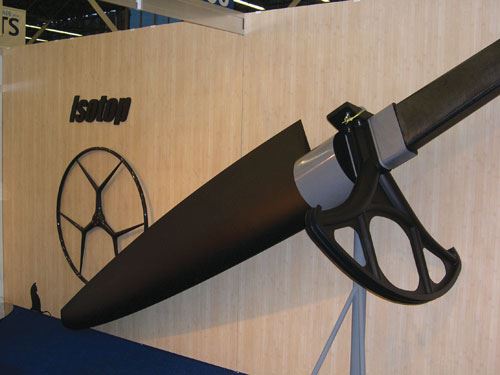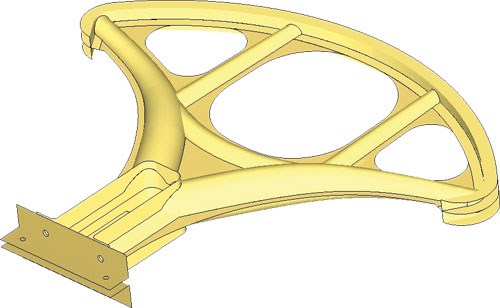Finite element analysis garners performance gains for yacht component
In the ongoing quest to reduce weight in high-performance sailing yachts, no part goes unexamined or untouched.
In the ongoing quest to reduce weight in high-performance sailing yachts, no part goes unexamined or untouched. Composites technology and engineering firm High Modulus (Hamble, U.K.) recently contracted with composite rudder specialist Isotop (Marans, France) to conduct a structural design and optimization study on a carbon composite rudder quadrant for a 100-ft/31m boat to reduce its weight.
A key structural part, the rudder quadrant is shaped like a piece of pie and is mechanically fastened to the vertical rudderpost or “stock.” Cables that run inside the grooves in the rounded outer edge act to turn the quadrant and the stock, giving the skipper directional control via a steering wheel or tiller. The baseline design for the quadrant was a flat, cored carbon/epoxy sandwich panel with material buildups near the stock for additional strength. High Modulus engineers estimated that 30 to 50 percent of the weight could be in the core.
With the help of finite element analysis (FEA) modeling, the engineers took a clean-sheet approach, pursuing an uncored design strong enough to meet the mechanical requirements for stiffness and torque resistance. First, they conducted solid-element topology optimization, considering the part’s geometric constraints and the available space within the hull. The exercise showed that a hollow, truss-like design could meet the structural requirements. A solid surface model (see drawing) was developed, with the idea that the part would be fabricated in a two-piece clamshell mold, with an upper half and a lower half. The two parts would be bonded together to form the quadrant.
Next, a shell element topology optimization step was completed, which dictated the size and location of buildups and the fiber orientation of each ply for optimum strength. While construction drawings were developed, a further FEA iteration was run as a final check, says High Modulus, to confirm sufficient buckling stability performance.
Isotop converted the construction drawings into mold geometry and molded the part with unidirectional and ±45° carbon/epoxy prepregs from Gurit UK (Newport, Isle of Wight, U.K.). The finished quadrant, recently displayed at the Marine Equipment Trade Show, Nov. 18-20 in Amsterdam, weighed 25 percent less than the baseline cored structure.
Related Content
-
3D-printed CFRP tools for serial production of composite landing flaps
GKN Aerospace Munich and CEAD develop printed tooling with short and continuous fiber that reduces cost and increases sustainability for composites production.
-
CFRTP enables better, greener smartphones
Carbon Mobile’s “monocoque” design eliminates separate case, cover and frame, better protects electronics and simplifies disassembly.
-
Composite prepreg tack testing
A recently standardized prepreg tack test method has been developed for use in material selection, quality control and adjusting cure process parameters for automated layup processes.

















.jpg;maxWidth=300;quality=90)
